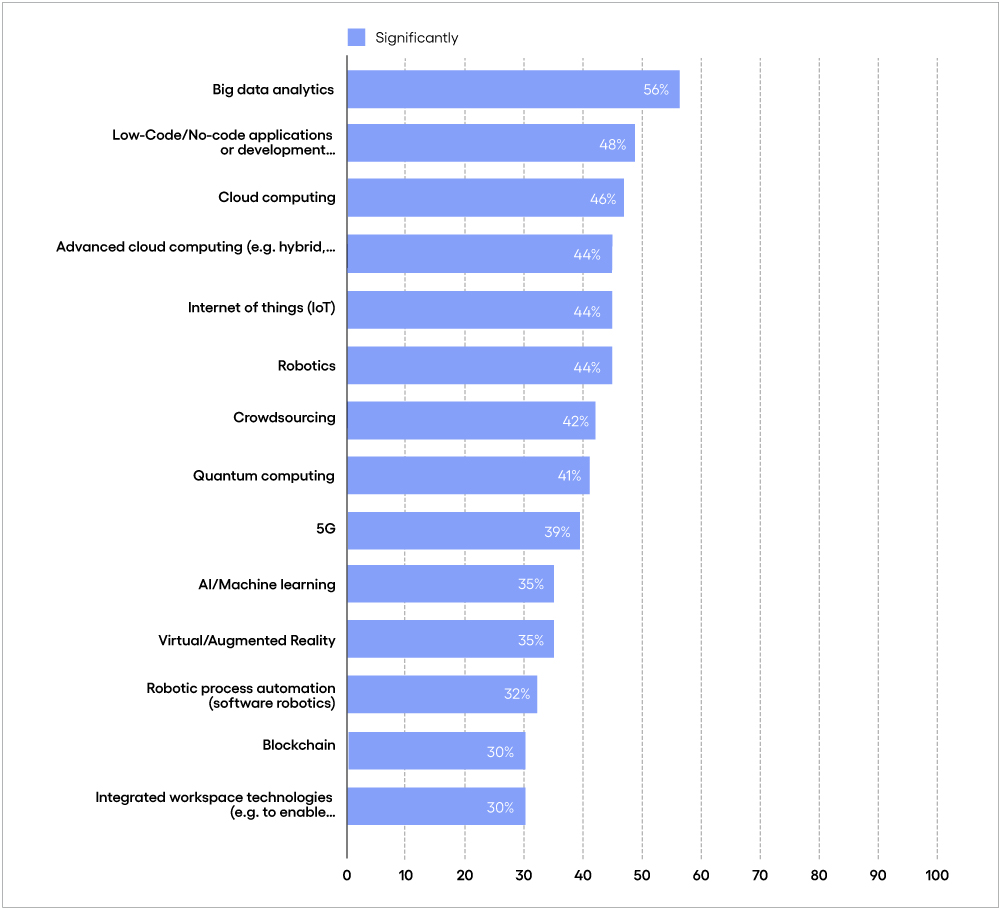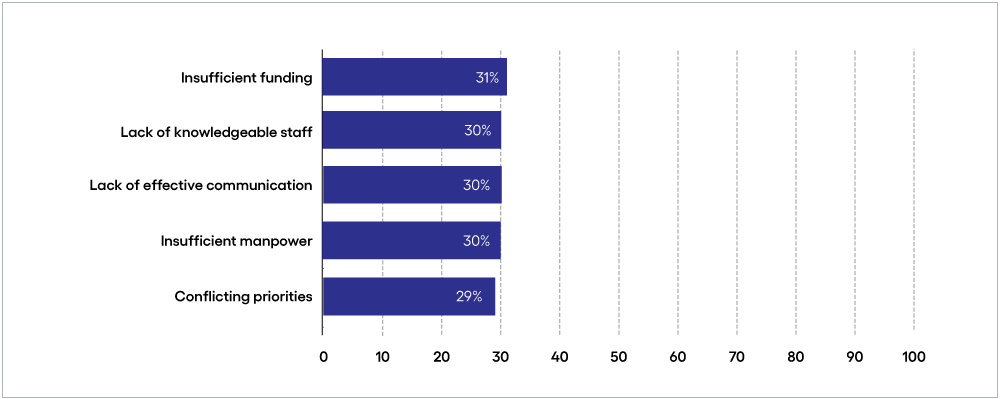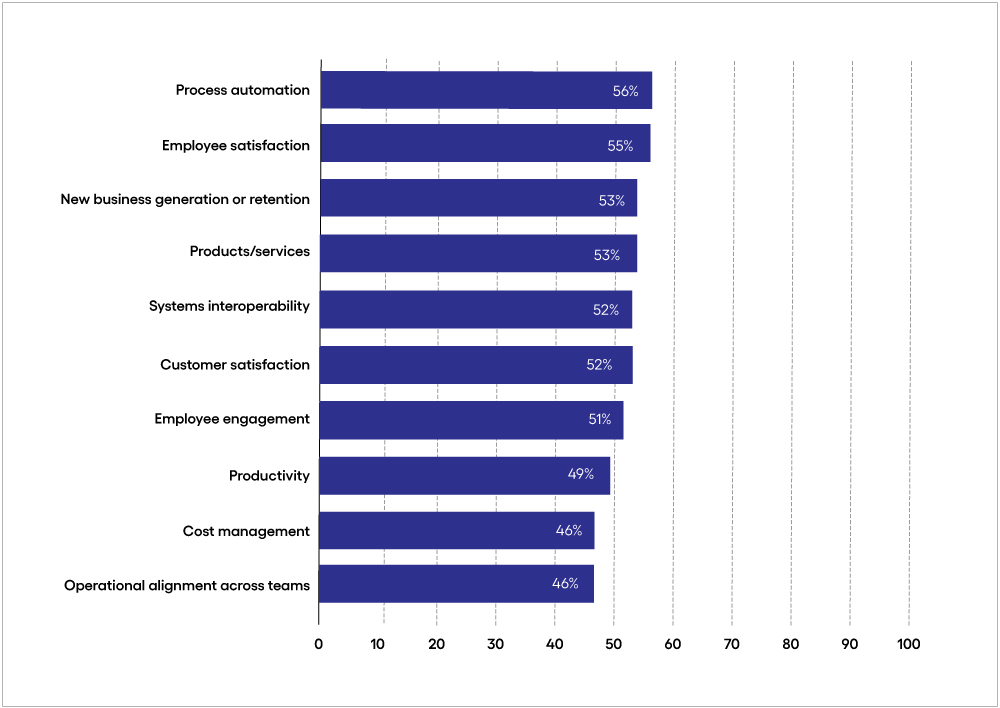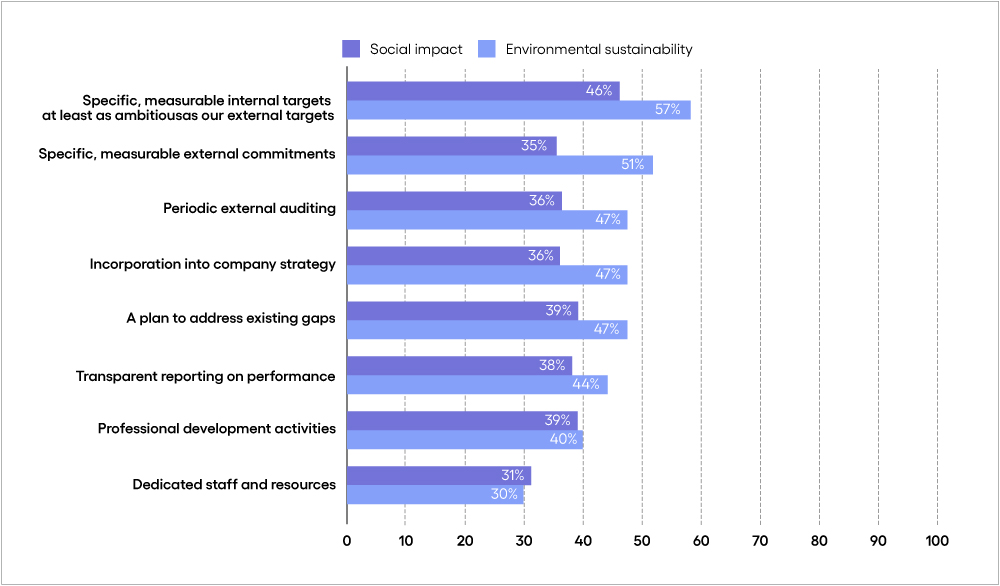August 19, 2022
How Australian businesses can unlock digital value to become future-fit
Australian businesses have made ample investment in digital technologies. Now it’s time to use technology to transform business and deliver value.
Australia’s businesses are at a critical juncture. After decades of change—both disruptive and insidious in nature—that altered long-held norms and ways of doing business, they face a game-changing choice: Continue working the old-fashioned way and risk punishing outcomes or focus their technology investments on business and operational innovation.
Choosing the latter will require tight alignment of technology initiatives with business goals, process digitization and sure-footed strategic planning. It seems, however, that many Australian businesses are failing to read the writing on the wall.
This, in a nutshell, is a key finding of recent Economist Impact research supported by Cognizant. (To learn more, see our report, “Advance Australia prepare: how to make Australian businesses future-ready”.)
Our analysis of Economist Impact data reveals that Australian businesses emerged from the pandemic heavy on technology but short on the ability to unlock strategic value from these investments, pivot working capital to drive productivity gains and achieve environmental, sustainability and governance (ESG) targets.
What stands out is that Australian businesses are behind their counterparts in other regions when it comes to fully embracing digital-first business models. This has repercussions far and wide.
Business leaders in Australia face three major challenges in achieving these objectives:
- The transformation gap. Australian organizations are behind other countries in translating high technology adoption into enterprise transformation, from digital business model innovation (strategy) to process digitization (operations). Moreover, the misalignment of business strategy and measurement frameworks means that while projects perform well against traditional IT metrics (being on-budget and on-time), they are not delivering against business objectives.
- The process–productivity paradox. Modern operating models need cross-functional teams with the right digital skills and that are empowered by clear governance and decision making with tech-savvy leadership at all levels. While few respondents in the study report talent gaps, suboptimal digitization of workflows and lagging investments in re-training and/or redeployment of talent are causing Australia’s businesses to miss out on opportunities to capture value through process digitization.
- Mismatched operational priorities. Australian businesses are also behind other countries in prioritizing operational enhancements across the organization. Below-par operational alignment and an inability to put data to use have cascading effects downstream, ultimately impacting organizations’ ability to predict change and innovate.
Addressing these challenges calls for an assessment of the roadblocks faced by businesses and a clear plan of action to address them. Here are steps Australian leaders can take to get started.
Transform business, not just technology
Australian businesses have invested in core, advanced and emerging technologies. More than 80% have invested in, or plan to invest in, cloud and Internet of Things (IoT), and more than 60% say the same about artificial intelligence (AI)/machine learning, low-/no-code technologies and advanced cloud.
But this investment has yet to translate into significant realized value (see Figure 1). To boost return on value, Australian companies will need to better align their technology initiatives and operations with evolving business models and build the necessary talent pool to unlock tech’s potential.
Businesses struggle to unlock the full potential of their tech
To what extent are the technologies/methodologies already adopted by your business department delivering strategic value to your operations? (Percent of respondents saying significant value)
Response base: 400 senior business executives
Source: Economist Impact Survey 2022
Figure 1
Where things stand
A whopping 70% of Australian respondents do not consider a digital-first business model to be a business-critical strategic priority, compared with the average of 62% of overall respondents. Similarly, short- to medium-term future planning (two to five years) is not a high priority for 31% of Australian respondents, compared with 24% overall. This finding could highlight businesses’ focus on building resilience against the impact of long-term business cycles, and a willingness to forego quick wins.
On the implementation side, 10% of Australian business leaders have failed to link implementation of advanced technologies to their business goals, compared with 6% of overall respondents. Respondents also reported a lower rate of operational alignment between business lines and functions compared with other countries.
To be truly future-ready, Australia’s leaders must work to break down silos, digitize processes and streamline workflows. They need to ensure that process, technology and data decisions are made with growth, profit or cost metrics in mind. The cross-functional execution of business change needs to be done with a digital-first mindset to approaching business processes and workflows. Transformation must take place in the core of the business in order to drive sustainable results.
Plan of action
- Align your leadership team on digital vs. non-digital business model options for your organization and reassess applicability. With digital becoming a pervasive channel for delivering products, services and employee experiences—combined with new entrants and blurring industry lines—organizations need to have clear answers to the digital business model question, before it is too late.
- Evaluate high-level business cases for medium-term opportunities for front-stage experience and backstage process digitization. For example, a high-quality customer experience is supported by not just customer-facing touchpoints but also by simple, effective processes that support these touchpoints.
An example is enabling customers to accept package delivery remotely by digitizing the entire package delivery process, including tracking parcels while still on the truck. Companies that invest in customer-facing touchpoints, but fail to modernize their core, will miss opportunities.
- Review your technology strategy to consider the use of advanced technology and align it to business goals. Start by bridging cultural gaps between tech and business teams and deploying technologies such as low-code/no-code tools that allow non-IT employees to work with high-end technologies and thus deepen IT capabilities.
- Review portfolio management to identify opportunities to improve quality and speed the pace of execution. Continuously monitor employee satisfaction and engagement and foster an enabling business culture.
Case in point
We are helping a leading Australian financial services organization better align its technology portfolio to business objectives and measure the execution of these endeavors. Doing so will enable the company to make prioritization calls based on business value, which is essential in a resource-constrained environment.
Address the process–productivity paradox
Australian businesses need to balance their pursuit of productivity and automation improvements with an imperative to fill talent gaps. As many as 30% of respondents list workforce issues among their top challenges when implementing new processes, products, services, and technologies (see Figure 2).
Top implementation challenges are workforce-related
Which of the following were the most significant challenges for your business department when implementing new processes, products, services, and technologies in the past year? Select up to five. (Percent of respondents saying significant challenge)
Response base: 400 senior business executives
Source: Economist Impact Survey 2022
Figure 2
Where things stand
While just 10% of Australian business leaders say they lack access to the talent needed to implement and utilize advanced technologies, only 49% have realized a significant productivity boost as a result of their technology initiatives (compared with 55% who said they expected a productivity infusion). Importantly, just 35% say they leverage data to align skill development/training with organizational needs.
On the process side, 56% are yet to see significant positive impact of technology adoption on their process automation efforts. Meanwhile, 35% of Australian businesses do not see automated and effective end-to-end business processes as business-critical or high-priority, compared with 30% overall. In an increasingly complex tech environment, these businesses face a heightened risk of unforced errors in the form of poor customer experiences, broken workflows, and poor process handoffs.
Plan of action
- Review your talent strategy to ensure it sufficiently addresses emerging and advanced technology skills. With digital skills in short supply, Australia’s businesses need talent strategies geared toward bridging skills gaps through reskilling or upskilling, as well as retaining hard-to-find talent.
- Review productivity improvement project plans against actual results to understand the challenges, and use this data to inform new productivity opportunities. As tech takes over routine tasks, it’s critical to strike the human-machine balance. This can be done by ensuring digital systems deliver the data that can support better decisions, while also creating a corporate culture that fortifies employees’ skills around using and trusting the data and insights generated by machines.
- Evaluate the value to be extracted from digital operating models that can transform products and services, reduce cost and allow for the re-deployment of working capital. Tech adoption is just the first step in this pursuit. Australian leaders must cultivate an understanding of what technology can help them achieve and create the necessary pathways to do so.
Case in point
We recently worked with one of Australia’s top banks to re-engineer its business processes to drive improved merchant operations performance, codify regulatory processes and improve the customer experience. This was done by combining deep banking process and automation knowledge to allow the client to both transform now to unlock value, and to plan for medium-term automation for the end-to-end process.
Modernize operations
Australian businesses are keen on enhancing their ability to react to a changing business landscape. As many as 56% rate the ability to anticipate and adapt to changing business environment/customer needs as very important. But this aspiration is not matched by their efforts to do so; most have yet to see a significant impact from technology improvement on operational alignment (see Figure 3).
Operational alignment lags when it comes to technology impact
What impact, if any, have your company's technology improvement efforts had on the following business areas over the past year? Select one for each. (Percent of respondents saying significant positive impact)
Response base: 400 senior business executives
Source: Economist Impact Survey 2022
Figure 3
Where things stand
While 38% of global respondents rate operational efficiency/resilience as business-critical, just 31% of respondents in Australia say so. Similarly, while 37% of global respondents rate operational alignment between business lines and functions as business-critical, only 30% of Australian respondents do so.
Tellingly, however, just 31% rate data-driven operations and mindset as business-critical, compared with 37% overall. This mindset impedes the ability of Australian businesses to generate insights that can guide decisions and results in suboptimal operational performance.
Plan of action
- Leverage data-heavy tech, such as cloud, IoT and big data analytics, to glean insights into operational roadblocks and free up processes that could unlock savings in terms of time, energy and costs.
- Improve day-to-day workflows by removing barriers in lines of communication to uncover operational issues impacting work on a daily basis and judiciously automating processes to ease workflows and improve resource allocation.
Case in point
We are working with a local resources company to establish digital teams that are focused on leveraging rich reserves of existing company data (all equipment is heavily instrumented), to identify the most valuable opportunities to unlock business value. An example of one of these projects involves using data to optimize processes in a processing plant, with the goal of improving the overall quality of the raw resource, thereby significantly increasing revenue.
Capturing data using integrated data storage and forming agile digital technology teams embedded in the business are both key to prioritizing and experimenting with the most worthwhile projects to meet or exceed business goals and objectives.
Double down on ESG
The business value opportunity from ESG concerns is greater in Australia than other countries, and we’re seeing positive change driven mainly by investors and consumers. But there is the potential for more. When asked about measures being taken to promote environmental sustainability and social impact, fewer than half of Australian businesses in most cases say they are implementing any of the eight measures listed to promote the latter (see Figure 4).
Measures taken to promote ESG
In which of the following ways does your company promote environmental sustainability and social impact? Select all that apply. (Percent of respondents)
Response base: 400 senior business executives
Source: Economist Impact Survey 2022
Figure 4
Where things stand
Almost half of Australian respondents strongly agree that their organization is accountable to society at large through both social initiatives and day-to-day operations, compared with 43% for other countries. Close to 90% believe that having the right governance, policies and ethical business practices in place is important to being a modern business.
However, less than 30% say they monitor data related to key aspects of sustainability, such as volume and sources of waste production and pollution (29%), water use (24%) and the gender pay gap (24%).
Plan of action
- Review how your business goals and technology priorities align with the ESG strategy.
- Pilot ESG data products to help build the business case for key opportunity areas against ESG objectives.
Case in point
We are working with a large resources sector client to develop an ESG data strategy to help its business and technology teams develop strategic investments and plan key initiatives in support of the company’s net-zero ambition. The ESG data strategy, together with an operational blueprint, provides a net-zero framework with clear operational milestones designed to accelerate value.
Becoming future-fit
Economist Impact data supported by Cognizant highlights the opportunity for Australia’s businesses to realize a future-ready state. To this end, we believe Australian leaders need to re-examine business performance through the lens of process transformation, institute robust tech governance, and focus on workforce strategy to solve the productivity paradox with an eye on ESG.
The common thread throughout these endeavors is value—which can only be achieved by intentionally and effectively knitting together the enterprise strategy through to execution.
To learn more, visit the Modern Business section of our website, or contact us.
The views and opinions expressed in this report are those of Cognizant and do not necessarily reflect the view and policies of Economist Impact. Data presented is from an Economist Impact executive survey, commissioned by Cognizant, conducted in early 2022.
This article was written by George Evans, Head of Consulting ANZ.
We’re here to offer you practical and unique solutions to today’s most pressing technology challenges. Across industries and markets, get inspired today for success tomorrow.
Latest Posts
Related topics
Get actionable business Insights in your inbox
Sign up for the Cognizant newsletter to gain actionable AI advice and real-world business insights delivered to your inbox every month.



















